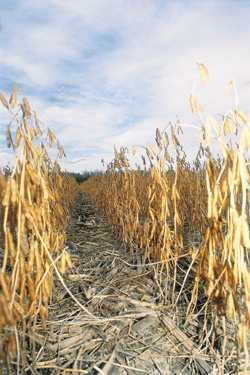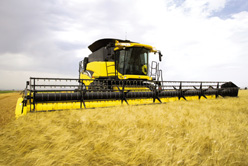
Features
Fungicides
Seed & Chemical
Tracking resistance
One thing growers have learned about resistance: they could be one application away from
having it.
March 4, 2008 By Rosalie I. Tennison
When it was observed that products used to control Colorado potato beetle (CPB) or weeds or disease were not working as well as they had previously, it took researchers a very short time to identify the problem as tolerance to or resistance of the active ingredients in the product. To ensure that the problem did not become wide spread, a resistance strategy was developed to reduce the increase of tolerance. Now, many years later, the question is not ‘Why is this happening’ but ‘How do I prevent it?’
 |
Unfortunately, companies are unable to develop new chemistry quickly enough to give growers more options to minimize resistance evolution. For example, when Admire was introduced, growers embraced the new chemistry and its effectiveness, but in some areas of the country CPB resistance appeared quickly. The problem could have been minimized if there had been more insecticide rotation options.
In terms of disease, a potato pest specialist in Manitoba says there is a long list of fungicides which are ineffective on the target diseases and several more are at risk. According to Dr. Tracy Shinners-Carnelley of Manitoba Agriculture, Food and Rural Initiatives, there are not enough options to give growers a choice of effective products. But, what can growers do and what can they expect to see in the way of products or strategies? Shinners-Carnelley says nothing replaces using products within a resistance management strategy. “Growers need to make sure the products are used in a manner to minimize resistance,” she says. “One of my concerns is for the early blight specific products because the number of applications are going up and this is increasing the risk. Since they have been available for about eight years, we could soon see some resistance.”
The intensity of potato production could be to blame for the high level of resistance that has developed to products. “When you consider the number of products available to potato growers, some have resistance issues,” says Shinners-Carnelley. “The potato industry has many examples of pathogens that have developed resistance.”
 |
| Resistance is appearing across the board from seed piece treatments to insecticides to post-harvest products. |
The same is true for the insecticides available to potato growers where CPB is a major issue, according to an entomologist in Shinners-Carnelley’s office. “Colorado potato beetle is a phenomenal insect because it develops resistance much quicker than many other pests,” says Brent Elliott. “We have had Admire available for about 10 years and most newer products are in the same insecticide class. As a result, there are few products to alternate with to help slow the development of resistance.”
The neonicotinoid products were embraced because of their ease of use and they were effective, but there are new products in development that need more attention to application. One that has made it through registration is very effective, but requires additional management so growers are slow to embrace it. Some of the new products require application at a specific point of insect development, which makes correct application timing a challenge. But, by sticking to the easier-to-apply products, growers are setting themselves up for bigger problems. Elliott says growers could use one of the products they set aside when Admire was introduced and they may get good control once, but the resistance rebounds quickly. “I’d like to see Admire used in only three out of four years in Manitoba,” says Elliott. Then he adds: “But that is unlikely to happen.”
Unfortunately for potato producers, resistance is appearing across the board from seed piece treatments to insecticides to post-harvest products. “We have found resistance in fusarium to fludioxonil, the active ingredient in the seed piece treatment Maxim,” says Rick Peters, a research scientist with Agriculture and Agri-Food Canada in Charlottetown, Prince Edward Island. “We’ve seen resistance in fusarium and Helminthosporium to Mertect, a thiabendazole product, move from west to east in Canada. There is also resistance to thiophanate-methyl, a seed piece treatment that controls silver scurf and fusarium seed decay.”
Peters says growers need post-harvest products because controlling temperature and humidity, while helpful, are not always effective at controlling storage diseases. Other products, such as phosphorus acid, are showing promise and could be available soon to help control pink rot and late blight.
Shinners-Carnelley says the fact that resistance will eventually develop to many products if they are over used means that growers have to take seriously the need for a resistance management strategy. This might require more planning, but it is the only way to stop the march of resistance development.
“Growers need to manage their pest pressure and apply products at the optimum time,” says Shinners-Carnelley. “The more applications a grower uses, the more chance of resistance developing. I’m not advocating slacking off on protections, particularly in the case of late blight, but growers should be alternating fungicides with other fungicides from a different group, meaning that they have a different mode of action. Tank-mixing fungicides is also important for good resistance management.” Growers need to respond to disease risk and apply the appropriate product as needed, she says, but not over use products and make sure to use them preventively.
 |
| Do not use the same type of product for two operations. |
Peters says rotation is key. Do not use the same type of product for two operations, he advises. “If you use one class of product as a seed piece treatment, don’t use a fungicide from the same group post-harvest. Try mixing modes of action and always use label rates.” He also reminds growers to try to prevent bruising during harvest so disease does not have an avenue to infect the tubers, and continuously monitor storage environment.
“There is always resistance potential,” says Elliott. “I think we can expect to see resistance develop to most products within 10 years after introduction.” Unless, he adds, growers use any new chemistry judiciously to minimize the risk.
Field monitoring is probably the best defense against resistance development, says Shinners-Carnelley. Knowing what is happening in the field could mean a reduction in applications if the pest pressure is low. Growers who have a strict spray regimen that is based on a timetable and not on pest pressure may have more problems develop down the road.
While these potato specialists are not specific about which products are showing signs of resistance development, they agree that all products are at risk unless growers use them carefully and in a strategy to minimize resistance development. “Just because we don’t see resistance to a particular product right now, doesn’t mean it won’t happen,” says Elliott.
Where resistance used to be a blip on the crop protection radar screen, it is now a steady signal. The only answer is wise use of products and a willingness to adjust application procedures to minimize resistance development. -end-